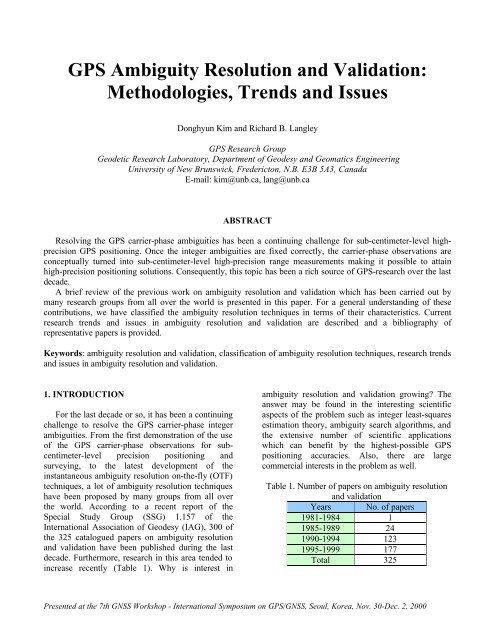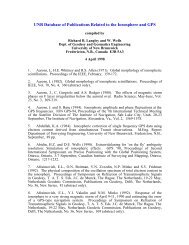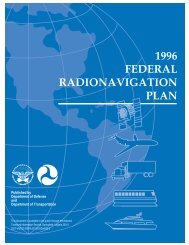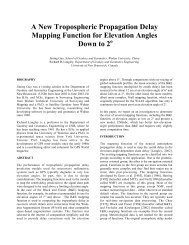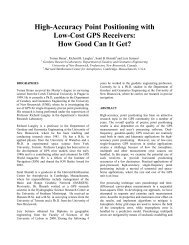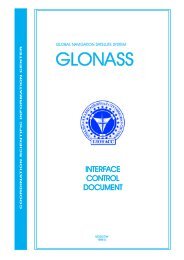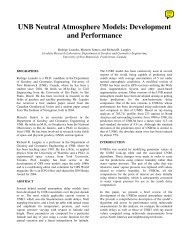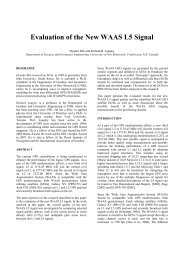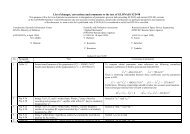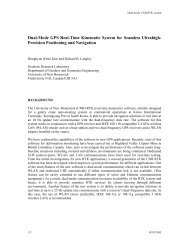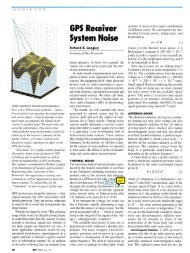GPS Ambiguity Resolution and Validation - University of New ...
GPS Ambiguity Resolution and Validation - University of New ...
GPS Ambiguity Resolution and Validation - University of New ...
You also want an ePaper? Increase the reach of your titles
YUMPU automatically turns print PDFs into web optimized ePapers that Google loves.
<strong>GPS</strong> <strong>Ambiguity</strong> <strong>Resolution</strong> <strong>and</strong> <strong>Validation</strong>:<br />
Methodologies, Trends <strong>and</strong> Issues<br />
Donghyun Kim <strong>and</strong> Richard B. Langley<br />
<strong>GPS</strong> Research Group<br />
Geodetic Research Laboratory, Department <strong>of</strong> Geodesy <strong>and</strong> Geomatics Engineering<br />
<strong>University</strong> <strong>of</strong> <strong>New</strong> Brunswick, Fredericton, N.B. E3B 5A3, Canada<br />
E-mail: kim@unb.ca, lang@unb.ca<br />
ABSTRACT<br />
Resolving the <strong>GPS</strong> carrier-phase ambiguities has been a continuing challenge for sub-centimeter-level highprecision<br />
<strong>GPS</strong> positioning. Once the integer ambiguities are fixed correctly, the carrier-phase observations are<br />
conceptually turned into sub-centimeter-level high-precision range measurements making it possible to attain<br />
high-precision positioning solutions. Consequently, this topic has been a rich source <strong>of</strong> <strong>GPS</strong>-research over the last<br />
decade.<br />
A brief review <strong>of</strong> the previous work on ambiguity resolution <strong>and</strong> validation which has been carried out by<br />
many research groups from all over the world is presented in this paper. For a general underst<strong>and</strong>ing <strong>of</strong> these<br />
contributions, we have classified the ambiguity resolution techniques in terms <strong>of</strong> their characteristics. Current<br />
research trends <strong>and</strong> issues in ambiguity resolution <strong>and</strong> validation are described <strong>and</strong> a bibliography <strong>of</strong><br />
representative papers is provided.<br />
Keywords: ambiguity resolution <strong>and</strong> validation, classification <strong>of</strong> ambiguity resolution techniques, research trends<br />
<strong>and</strong> issues in ambiguity resolution <strong>and</strong> validation.<br />
1. INTRODUCTION<br />
For the last decade or so, it has been a continuing<br />
challenge to resolve the <strong>GPS</strong> carrier-phase integer<br />
ambiguities. From the first demonstration <strong>of</strong> the use<br />
<strong>of</strong> the <strong>GPS</strong> carrier-phase observations for subcentimeter-level<br />
precision positioning <strong>and</strong><br />
surveying, to the latest development <strong>of</strong> the<br />
instantaneous ambiguity resolution on-the-fly (OTF)<br />
techniques, a lot <strong>of</strong> ambiguity resolution techniques<br />
have been proposed by many groups from all over<br />
the world. According to a recent report <strong>of</strong> the<br />
Special Study Group (SSG) 1.157 <strong>of</strong> the<br />
International Association <strong>of</strong> Geodesy (IAG), 300 <strong>of</strong><br />
the 325 catalogued papers on ambiguity resolution<br />
<strong>and</strong> validation have been published during the last<br />
decade. Furthermore, research in this area tended to<br />
increase recently (Table 1). Why is interest in<br />
ambiguity resolution <strong>and</strong> validation growing The<br />
answer may be found in the interesting scientific<br />
aspects <strong>of</strong> the problem such as integer least-squares<br />
estimation theory, ambiguity search algorithms, <strong>and</strong><br />
the extensive number <strong>of</strong> scientific applications<br />
which can benefit by the highest-possible <strong>GPS</strong><br />
positioning accuracies. Also, there are large<br />
commercial interests in the problem as well.<br />
Table 1. Number <strong>of</strong> papers on ambiguity resolution<br />
<strong>and</strong> validation<br />
Years No. <strong>of</strong> papers<br />
1981-1984 1<br />
1985-1989 24<br />
1990-1994 123<br />
1995-1999 177<br />
Total 325<br />
Presented at the 7th GNSS Workshop - International Symposium on <strong>GPS</strong>/GNSS, Seoul, Korea, Nov. 30-Dec. 2, 2000
The <strong>GPS</strong> carrier-phase ambiguity represents the<br />
arbitrary counter setting (an integer value) <strong>of</strong> the<br />
carrier-phase cycle tracking register at the start <strong>of</strong><br />
observations <strong>of</strong> a satellite (phase lock), which biases<br />
all measurements in an unbroken sequence <strong>of</strong> that<br />
satellite’s carrier-phase observations. Once the<br />
integer ambiguities are fixed correctly, the carrierphase<br />
observations are conceptually turned into<br />
millimeter-level high-precision range measurements<br />
<strong>and</strong> hence it is possible to attain sub-centimeter-level<br />
positioning solutions. However, fixing the integer<br />
ambiguities is a non-trivial problem, especially if we<br />
aim at computational efficiency <strong>and</strong> high<br />
performance (or success rate). Therefore, this topic<br />
has been a rich source <strong>of</strong> <strong>GPS</strong>-research over the last<br />
decade.<br />
In general, algorithms for solving the integer<br />
ambiguities have been developed for two different<br />
applications. The first group <strong>of</strong> the algorithms has<br />
been developed for applications using multireference<br />
stations in static mode. Multi-reference<br />
stations are occupied for several hours or even<br />
several days. Inter-station distance can reach<br />
thous<strong>and</strong>s <strong>of</strong> kilometres. Whereas the second group<br />
<strong>of</strong> the algorithms has been developed for rapidstatic,<br />
kinematic <strong>and</strong> navigation applications. Only<br />
two stations are usually involved with at least one<br />
station moving. The maximum distance between the<br />
stations is a few tens <strong>of</strong> kilometres. Time <strong>of</strong><br />
occupation is the order <strong>of</strong> seconds to minutes or<br />
even instantaneous. However, conceptually there are<br />
no differences between the two applications, <strong>and</strong> the<br />
research directed to one application can benefit from<br />
research conducted for the other. Moreover,<br />
particular interests such as real-time long-baseline<br />
kinematic applications integrate the two approaches.<br />
For a general underst<strong>and</strong>ing <strong>of</strong> this research area,<br />
it may be useful to take a look at previous work in<br />
the field <strong>and</strong> various research projects in progress.<br />
One good source <strong>of</strong> information where we can get an<br />
overview <strong>of</strong> research trends <strong>and</strong> issues on ambiguity<br />
resolution is the IAG Web site, particularly the<br />
reports <strong>of</strong> the SSGs which belong to Section I. IAG<br />
Section I is concerned with the scientific aspects <strong>of</strong><br />
measurements <strong>and</strong> the analysis <strong>of</strong> regional <strong>and</strong><br />
global geodetic networks as well as satellite, inertial,<br />
kinematic <strong>and</strong> marine positioning. One <strong>of</strong> the main<br />
activities <strong>of</strong> an SSG is the international coordination<br />
<strong>of</strong> the ongoing research in its field. The following<br />
SSGs are <strong>of</strong> particular interest:<br />
1) SSG 1.154 on “Quality issues in real time<br />
<strong>GPS</strong> positioning”,<br />
2) SSG 1.157 on “<strong>GPS</strong> ambiguity resolution<br />
<strong>and</strong> validation”,<br />
3) SSG 1.179 on “Wide area modeling for<br />
precise satellite positioning”.<br />
This paper attempts to review briefly the main<br />
issues <strong>and</strong> research trends in ambiguity resolution<br />
<strong>and</strong> validation. First, we will summarize the<br />
previous work which has been carried out by many<br />
research groups from all over the world. Then, we<br />
will take a look at recent research activity in the<br />
area.<br />
2. AMBIGUITY RESOLUTION TECHNIQUES<br />
Comparison <strong>of</strong> the ambiguity resolution<br />
techniques is not easy <strong>and</strong> not always feasible. The<br />
terms <strong>of</strong> reference <strong>of</strong> SSG 1.157 clarifies this point:<br />
“Despite the large effort spent by many groups<br />
from all over the world in devising various<br />
schemes, knowledge about their theoretical<br />
foundation, <strong>and</strong> how the schemes are related to<br />
each other, is still lacking. Different terminology<br />
is used <strong>and</strong> comparisons between methods are<br />
rare. Due to a lack <strong>of</strong> knowledge about the<br />
various methods, the implementations used in<br />
the comparisons (if made at all) are not always<br />
complete, thereby making the test results<br />
unreliable. Moreover, results reported <strong>of</strong> one<br />
particular method, are <strong>of</strong>ten difficult to relate to<br />
the results <strong>of</strong> another method, due to lacking<br />
knowledge <strong>of</strong> the characteristics <strong>of</strong> the data <strong>and</strong><br />
the type <strong>of</strong> computer that was used.”<br />
As a result, comparison <strong>of</strong> the ambiguity<br />
resolution techniques in terms <strong>of</strong> computational<br />
efficiency <strong>and</strong> performance is not always reliable.<br />
To avoid this pitfall, we will restrict our interest to<br />
categorizing the techniques in terms <strong>of</strong> individual<br />
characteristics.<br />
Presented at the 7th GNSS Workshop - International Symposium on <strong>GPS</strong>/GNSS, Seoul, Korea, Nov. 30-Dec. 2, 2000
Classification based on measurement information<br />
utilization<br />
So far, there is only one paper which has<br />
presented a comprehensive study <strong>of</strong> the<br />
classification <strong>of</strong> the ambiguity resolution techniques<br />
[Hatch <strong>and</strong> Euler, 1994]. In the paper, many<br />
ambiguity resolution techniques are classified<br />
according to how they attempt to make use <strong>of</strong> the<br />
information contained within the receiver<br />
measurements. Although some papers briefly<br />
describe (usually in an introduction) their own<br />
classification, there is no significant difference from<br />
that <strong>of</strong> Hatch <strong>and</strong> Euler. The classification is threefold:<br />
1) <strong>Ambiguity</strong> resolution in the measurement<br />
domain,<br />
2) Search technique in the coordinate domain,<br />
3) Search technique in the ambiguity domain.<br />
Technique<br />
Table 2. Characteristics <strong>of</strong> ambiguity resolution techniques.<br />
<strong>Ambiguity</strong> Data<br />
Principal<br />
Search Processing<br />
Author(s)<br />
Method* Method*<br />
Search Space<br />
H<strong>and</strong>ling<br />
Method*<br />
LSAST Hatch Independent Single-epoch None<br />
FARA Frei <strong>and</strong> Beutler All Multi-epoch Conditional<br />
Modified Cholesky<br />
Decomposition<br />
Euler <strong>and</strong> L<strong>and</strong>au All Multi-epoch None<br />
LAMBDA Teunissen All Multi-epoch<br />
Transformation<br />
/Conditional<br />
Null Space Martin-Neira Independent Single-epoch Transformation<br />
FASF<br />
Chen <strong>and</strong><br />
Lachapelle<br />
All Multi-epoch Conditional<br />
Single/Multi-<br />
OMEGA Kim <strong>and</strong> Langley Independent<br />
Epoch<br />
* Refer to the section “Classification based on methodology” for details.<br />
Transformation<br />
/Conditional<br />
The first class is the simplest ambiguity<br />
resolution technique which uses C/A or P-code<br />
pseudoranges directly to determine the ambiguities<br />
<strong>of</strong> the corresponding carrier-phase observations.<br />
Since the precision <strong>of</strong> raw C/A or even P-code<br />
pseudoranges is, however, generally not good<br />
enough to determine the integer ambiguities, interfrequency<br />
linear combinations <strong>of</strong> the L1 <strong>and</strong> L2<br />
observations are used with a smoothing process for<br />
the estimated ambiguities. There are a few papers<br />
which give comprehensive studies <strong>of</strong> the interfrequency<br />
linear combinations (see, for example,<br />
Cocard <strong>and</strong> Geiger [1992], Collins [1999]).<br />
The second class <strong>of</strong> algorithms includes the very<br />
first ambiguity resolution technique developed,<br />
namely the <strong>Ambiguity</strong> Function Method (AFM)<br />
[Counselman <strong>and</strong> Gourevitch, 1981; Remondi, 1984].<br />
This technique uses only the fractional value <strong>of</strong> the<br />
instantaneous carrier-phase measurement <strong>and</strong> hence<br />
the ambiguity function values are not affected by the<br />
whole-cycle change <strong>of</strong> the carrier phase or by cycle<br />
slips. Despite significant improvement <strong>of</strong> the<br />
original algorithm by Han <strong>and</strong> Rizos [1996], the<br />
technique provides relatively poor computational<br />
efficiency <strong>and</strong> consequently it is <strong>of</strong> little import<br />
other than <strong>of</strong> historical interest.<br />
The third class comprises the most abundant<br />
group <strong>of</strong> techniques which are based on the theory <strong>of</strong><br />
integer least-squares [Teunissen, 1993]. Parameter<br />
estimation under the theory is carried out in three<br />
steps – the float solution, the integer ambiguity<br />
estimation, <strong>and</strong> the fixed solution. Each technique<br />
makes use <strong>of</strong> the variance-covariance matrix<br />
obtained at the float solution step <strong>and</strong> employs<br />
different ambiguity search processes at the integer<br />
ambiguity estimation step. The following are some<br />
Presented at the 7th GNSS Workshop - International Symposium on <strong>GPS</strong>/GNSS, Seoul, Korea, Nov. 30-Dec. 2, 2000
epresentative techniques in the class: the Least-<br />
Squares <strong>Ambiguity</strong> Search Technique (LSAST)<br />
[Hatch, 1990]; the Fast <strong>Ambiguity</strong> <strong>Resolution</strong><br />
Approach (FARA) [Frei <strong>and</strong> Beutler, 1990]; the<br />
modified Cholesky decomposition method [Euler<br />
<strong>and</strong> L<strong>and</strong>au, 1992]; the Least-Squares AMBiguity<br />
Decorrelation Adjustment (LAMBDA) [Teunissen,<br />
1994]; the null space method [Martin-Neira et al.,<br />
1995]; the Fast <strong>Ambiguity</strong> Search Filter (FASF)<br />
[Chen <strong>and</strong> Lachapelle, 1995]; <strong>and</strong> the Optimal<br />
Method for Estimating <strong>GPS</strong> Ambiguities (OMEGA)<br />
[Kim <strong>and</strong> Langley, 1999a].<br />
Classification based on methodology<br />
The ambiguity resolution techniques which<br />
belong to the first two classes delineated in the<br />
previous section are so straightforward that further<br />
discussion is not needed. As for the third class,<br />
however, an overarching point <strong>of</strong> view may be<br />
helpful in underst<strong>and</strong>ing the various techniques<br />
because each technique has more or less different<br />
characteristics. Therefore, in the remainder <strong>of</strong> this<br />
paper we will restrict our discussion to the<br />
techniques in the third class.<br />
Before we investigate the ambiguity resolution<br />
techniques further, we will consider the general<br />
goals <strong>of</strong> the techniques <strong>and</strong> discuss both the<br />
common <strong>and</strong> disparate aspects <strong>of</strong> the techniques. As<br />
can be seen in many papers, the general goals that<br />
the ambiguity resolution techniques try to achieve<br />
are to increase the performance <strong>of</strong> the integer<br />
ambiguity estimation <strong>and</strong> to improve the<br />
computational efficiency <strong>of</strong> the ambiguity search<br />
process. The performance <strong>of</strong> the integer ambiguity<br />
estimation, which means the capability to<br />
discriminate a correct ambiguity set from all<br />
c<strong>and</strong>idate sets, can be generally increased by means<br />
<strong>of</strong> more realistic stochastic models for receiver<br />
system noise (or observation noise) <strong>and</strong> well-defined<br />
validation procedures for the solutions.<br />
Unfortunately, it is not easy to distinguish one<br />
technique from the others based on their<br />
performance because almost all the techniques have<br />
common aspects as far as performance is concerned.<br />
In fact, it is the computational efficiency <strong>of</strong> the<br />
ambiguity search process rather than the<br />
performance that distinguishes the different<br />
ambiguity resolution techniques.<br />
Another common feature <strong>of</strong> the ambiguity<br />
resolution techniques can be found in the objective<br />
functions which are derived from the integer leastsquares<br />
problem. Many ambiguity resolution<br />
techniques which perform a search in the ambiguity<br />
domain are basically based on the minimization <strong>of</strong><br />
the quadratic form <strong>of</strong> the residuals. Principally, this<br />
minimization problem is referred to as an integer<br />
least-squares problem due to the integer-constraint<br />
for the ambiguity parameters. The same objective<br />
function, which is related to the minimization <strong>of</strong> the<br />
quadratic form <strong>of</strong> the residuals under the integer<br />
least-squares problem, can be derived using different<br />
approaches [Euler <strong>and</strong> L<strong>and</strong>au, 1992; Teunissen,<br />
1993; Kim <strong>and</strong> Langley, 2000a].<br />
With respect to the computation <strong>of</strong> the objective<br />
function, there are two basic approaches: a “singleepoch”<br />
(or instantaneous) approach <strong>and</strong> a “multiepoch”<br />
approach. A single-epoch approach uses one<br />
epoch’s observations while a multi-epoch approach<br />
uses many sequential observations in computing the<br />
quadratic form <strong>of</strong> the residuals. As far as the<br />
performance <strong>of</strong> ambiguity resolution is concerned,<br />
the single-epoch approach may not attain a higher<br />
success rate than the multi-epoch approach because<br />
the single-epoch approach <strong>of</strong>ten fails to find correct<br />
ambiguity parameters. This is due to the difference<br />
between a local <strong>and</strong> a global minimum for the<br />
quadratic form <strong>of</strong> the residuals. When the<br />
observations are significantly contaminated by<br />
biases such as multipath, residual atmospheric<br />
effects, satellite orbit error <strong>and</strong> so on, a local<br />
minimum which is determined using one epoch’s<br />
observations is apt to be biased. On the other h<strong>and</strong>, a<br />
global minimum which is determined using many<br />
sequential observations over a relatively long time<br />
span is unbiased as long as the behaviour <strong>of</strong> biases<br />
can be assumed to be a r<strong>and</strong>om process over the time<br />
span. Therefore, the single-epoch approach should<br />
be used with a procedure which improves ambiguity<br />
resolution performance. It has been reported that the<br />
performance <strong>of</strong> the single-epoch approach can be<br />
improved when a linear filter for the residuals is<br />
employed [Borge <strong>and</strong> Forssell, 1994] or when the<br />
time average <strong>of</strong> the objective function is used<br />
[Martin-Neira et al., 1995].<br />
As turns out to be clear (to some degree) from the<br />
above discussion, the ambiguity resolution<br />
techniques have different characteristics in terms <strong>of</strong><br />
Presented at the 7th GNSS Workshop - International Symposium on <strong>GPS</strong>/GNSS, Seoul, Korea, Nov. 30-Dec. 2, 2000
the computational efficiency <strong>of</strong> the ambiguity search<br />
process <strong>and</strong> hence we can classify the techniques<br />
according to their approaches for the search process.<br />
In classifying the techniques, we kept in mind two<br />
questions: 1) How do the techniques describe or<br />
limit the ambiguity search space <strong>and</strong> 2) How do the<br />
techniques deal with the ambiguity parameters<br />
The computational efficiency <strong>of</strong> the ambiguity<br />
search process can be improved in several ways. A<br />
general approach is to reduce the ambiguity search<br />
space which comprises the ambiguity c<strong>and</strong>idate sets.<br />
In this case, the correct ambiguity set should be<br />
retained in the reduced search space once the<br />
original search space includes it. We can find two<br />
methods for this approach. One is the search domain<br />
transformation method which transforms the original<br />
ambiguity sets into the corresponding ones in a<br />
transformed space. The reduction effect is usually<br />
gained through a “many-to-one” relationship<br />
between the original <strong>and</strong> transformed sets, <strong>and</strong>/or<br />
through redefining a more efficient search space<br />
than original one [Abidin, 1993; Martin-Neria et al.,<br />
1995]. The other method for reducing the search<br />
space is to define the conditional search ranges in<br />
multi-level searches (e.g., FARA <strong>and</strong> FASF). This<br />
method is based on the fact that the ambiguity<br />
parameters <strong>of</strong> lower search levels are conditioned on<br />
those <strong>of</strong> upper search levels. Some techniques use<br />
two methods simultaneously (e.g., LAMBDA <strong>and</strong><br />
OMEGA). Another approach for improving the<br />
computational efficiency is to find a more efficient<br />
computational algorithm for the quadratic form <strong>of</strong><br />
the residuals. There have not been many<br />
investigations into this approach except for studies<br />
on the modified Cholesky decomposition method<br />
[Euler <strong>and</strong> L<strong>and</strong>au, 1992] because the search space<br />
reduction methods usually obtain higher<br />
computational efficiency anyway. Moreover, we<br />
have already well-known computational algorithms<br />
for the quadratic form <strong>of</strong> the residuals, such as the<br />
singular value decomposition <strong>and</strong> the Cholesky<br />
decomposition. Note that the modified Cholesky<br />
decomposition is frequently used in the context <strong>of</strong><br />
the ambiguity resolution techniques due to a<br />
symmetric nonnegative definite matrix in the<br />
quadratic form <strong>of</strong> the residuals. Recent studies by<br />
Kim <strong>and</strong> Langley [1999b, 2000a] show that<br />
computational efficiency can be significantly<br />
improved using alternative algorithms for the<br />
quadratic form <strong>of</strong> the residuals.<br />
As mentioned previously, parameter estimation<br />
under the integer least-squares problem is carried out<br />
in three steps – the float solution, the integer<br />
ambiguity estimation, <strong>and</strong> the fixed solution.<br />
Regardless <strong>of</strong> which ambiguity resolution technique<br />
is used, the same computational algorithms can be<br />
employed for the float <strong>and</strong> fixed solutions. On the<br />
other h<strong>and</strong>, the procedures <strong>of</strong> the integer ambiguity<br />
estimation depend on the specific ambiguity search<br />
technique adopted. We can classify the ambiguity<br />
search techniques into two classes according to how<br />
they h<strong>and</strong>le the ambiguity parameters in the<br />
ambiguity search process – an “all-ambiguitysearch”<br />
method (e.g., FARA, LAMBDA, FASF <strong>and</strong><br />
the modified Cholesky decomposition method) <strong>and</strong><br />
an “independent-ambiguity-search” method (e.g.,<br />
LSAST <strong>and</strong> OMEGA). In generating the ambiguity<br />
search space, the first method uses all the ambiguity<br />
parameters while the second one uses only<br />
independent ambiguity parameters which provide an<br />
unique solution for the system (or observation<br />
equations) <strong>and</strong> hence dependent ambiguity<br />
parameters are determined once the independent<br />
ones are given [Hatch, 1990]. Generally, the<br />
independent-ambiguity-search method has a great<br />
efficiency in generating the ambiguity search space<br />
but computational efficiency <strong>of</strong> the method is not<br />
improved as much as expected because <strong>of</strong> the<br />
computational burden <strong>of</strong> the dependent ambiguity<br />
parameters. Kim <strong>and</strong> Langley [1999b, 2000a]<br />
proposes alternative algorithms to overcome the<br />
problem.<br />
3. RESEARCH TRENDS AND ISSUES<br />
Over the past decade, the ambiguity resolution<br />
techniques have been improved with the ambiguity<br />
search process made more efficient in order to make<br />
the ambiguity resolution techniques practical. As a<br />
matter fact, it is “computational efficiency” that the<br />
ambiguity resolution techniques have aimed at.<br />
Unfortunately, the race for more efficient ambiguity<br />
search algorithms seems to be already saturated<br />
because current achievements in computational<br />
efficiency seem sufficient for many practical<br />
applications. For example, some techniques such as<br />
FASF, LAMBDA <strong>and</strong> OMEGA provide ambiguity<br />
<strong>and</strong> positioning solutions within a few tens <strong>of</strong><br />
milliseconds according to their developers. Such<br />
speed is more than satisfactory for most applications.<br />
Presented at the 7th GNSS Workshop - International Symposium on <strong>GPS</strong>/GNSS, Seoul, Korea, Nov. 30-Dec. 2, 2000
Although many <strong>of</strong> the currently available techniques<br />
are quite efficient, this does not necessary mean that<br />
further investigations for better ambiguity search<br />
algorithms are pointless.<br />
On the contrary, ambiguity resolution techniques<br />
have not usually been described in terms <strong>of</strong> a<br />
generalized (or st<strong>and</strong>ard) procedure which includes:<br />
a functional (or deterministic) model which<br />
describes the relationship between observations <strong>and</strong><br />
unknown parameters; a stochastic model which<br />
represents the noise characteristics <strong>of</strong> the<br />
observations; a quality control scheme which<br />
h<strong>and</strong>les cycle slips (or outliers); <strong>and</strong> a parameterestimation<br />
scheme which determines ambiguity<br />
parameters as well as navigation solutions. As a<br />
result, it is not always clear if the results reported in<br />
the literature are isolated (“best”) cases or can be<br />
reproduced at any place on the earth at any time<br />
during the day. In fact, we need to consider the<br />
“reliability” <strong>of</strong> the techniques. IAG SSG 1.154 on<br />
“<strong>Ambiguity</strong> <strong>Resolution</strong> <strong>and</strong> <strong>Validation</strong>” had<br />
investigated the problem during the years 1995-1999.<br />
Unfortunately, the lack <strong>of</strong> a generalized procedure is<br />
still present although progress has been made.<br />
Furthermore, there is no general agreement on the<br />
form <strong>of</strong> the generalized procedure up to now.<br />
As was mentioned previously, the general goal <strong>of</strong><br />
the ambiguity resolution techniques includes the<br />
“performance” (or success rate) <strong>of</strong> ambiguity<br />
resolution. Although no comprehensive study has<br />
yet been performed, it is evident from many papers<br />
that concern about this aspect <strong>of</strong> ambiguity<br />
resolution has been growing. The issues related to<br />
performance are two-fold: 1) How do we increase<br />
performance <strong>and</strong> 2) How do we evaluate<br />
performance The first issue is involved with the<br />
qualitative realization <strong>of</strong> performance, whereas the<br />
second issue is related to the quantitative evaluation<br />
<strong>of</strong> performance.<br />
To obtain optimal solutions in the least-squares<br />
estimation, both a functional <strong>and</strong> a stochastic model<br />
should be specified appropriately. As long as the<br />
models are correct, in principle, the optimal<br />
solutions are not biased <strong>and</strong> hence we can obtain<br />
correct solutions. The same is true for the ambiguity<br />
parameter estimation because it is based on the<br />
integer least-squares estimation theory. Therefore,<br />
the realization <strong>of</strong> high performance (i.e., the<br />
determination <strong>of</strong> correct ambiguity parameter<br />
values) depends on how correctly we can establish<br />
the functional <strong>and</strong> the stochastic models. With<br />
respect to the function model, specific error<br />
modeling <strong>and</strong> parametric modeling for the error<br />
sources – ionospheric delay, tropospheric delay,<br />
satellite orbit error, multipath <strong>and</strong> so on – are<br />
essential concerns. Although intensive research has<br />
been conducted in this area, interest is still growing,<br />
particularly for the applications requiring real-time,<br />
long-baseline or kinematic solutions. On the other<br />
h<strong>and</strong>, stochastic modeling has received less attention<br />
than functional modeling. However, the stochastic<br />
modeling turns out to be a crucial research topic as<br />
the interest in the performance <strong>of</strong> ambiguity<br />
resolution increases. The race for more realistic<br />
stochastic models is in full swing at this moment<br />
with many recent developments: the elevation-angle<br />
dependent function approach [Jin, 1996]; the signalto-noise<br />
ratio (SNR) or alternatively the carrier-tonoise-power-density<br />
ratio (C/N 0 ) approach<br />
[Hartinger <strong>and</strong> Brunner, 1998; Barnes et al., 1998;<br />
Collins <strong>and</strong> Langley, 1999]; the (adaptive) leastsquares<br />
estimation approach [Wang et al., 1998a;<br />
Wang, 1999; Tiberius <strong>and</strong> Kenselaar, 2000] <strong>and</strong> the<br />
real-time estimation approach [Han, 1997; Kim <strong>and</strong><br />
Langley, 2000c]. Fundamental discussions about the<br />
observation noise were given by Langley [1997] <strong>and</strong><br />
Tiberius et al. [1999]. IAG SSG 1.179 on “Wide<br />
Area Modeling for Precise Satellite Positioning” will<br />
be closely related to the issues <strong>of</strong> functional <strong>and</strong><br />
stochastic modeling during the years 2000-2003.<br />
There are two approaches for the evaluation <strong>of</strong><br />
performance: 1) the performance evaluation function<br />
approach <strong>and</strong> 2) the discrimination function<br />
approach. The first approach tries to evaluate the<br />
performance <strong>of</strong> the integer ambiguity parameters<br />
using the probabilistic properties <strong>of</strong> the integer<br />
ambiguity estimators. Teunissen [1998, 1999] has<br />
proposed a performance evaluation function,<br />
particularly for the integer bootstrapping (i.e.,<br />
sequential conditional integer rounding) technique<br />
which was adopted in the LAMBDA method. On the<br />
other h<strong>and</strong>, the second approach tries to measure<br />
discrimination power between the best ambiguity<br />
c<strong>and</strong>idate <strong>and</strong> the second-best one. Although some<br />
discrimination test procedures have been proposed<br />
during the past decade, more reliable test procedures<br />
which can quantify discrimination power have been<br />
proposed only recently [Han, 1997; Wang et al.,<br />
Presented at the 7th GNSS Workshop - International Symposium on <strong>GPS</strong>/GNSS, Seoul, Korea, Nov. 30-Dec. 2, 2000
1998b]. Compared with the activities for the<br />
qualitative realization mentioned previously, the<br />
research on the quantitative evaluation is less intense<br />
so far. Nevertheless this topic is ripe enough to start<br />
a race.<br />
With an increased level <strong>of</strong> research on (real time)<br />
long-baseline (kinematic) applications recently,<br />
some <strong>of</strong> this research has shown up in the ambiguity<br />
resolution arena. Although we have already noted<br />
the extensive ambiguity resolution research over the<br />
past decade, this research was usually directed<br />
towards post-processing <strong>and</strong> static applications. But<br />
all the issues mentioned above (i.e., computational<br />
efficiency, reliability <strong>and</strong> performance) are inherent<br />
in the real-time, long-baseline, or kinematic<br />
applications. For example, functional modeling turns<br />
out to be difficult because <strong>of</strong> the decorrelation <strong>of</strong><br />
such biases as ionospheric delay, tropospheric delay<br />
<strong>and</strong> satellite orbit error in long-baseline situations,<br />
<strong>and</strong> the quasi-r<strong>and</strong>om behavior <strong>of</strong> multipath in<br />
kinematic situations. As a result, stochastic<br />
modeling also turns out to be more difficult. On the<br />
other h<strong>and</strong>, those problems can be h<strong>and</strong>led relatively<br />
easily in static <strong>and</strong> short-baseline applications.<br />
Conventionally, the multi-reference station<br />
approaches have been proposed to overcome the<br />
problems in (post-processing) long-baseline (static)<br />
applications (see Fotopoulos [2000]). The capability<br />
<strong>of</strong> real-time <strong>and</strong> kinematic processing has been<br />
investigated using the virtual reference station<br />
approach [van der Marel, 1998; Odijk et al., 2000]<br />
<strong>and</strong> the parametric estimation approach [Kim <strong>and</strong><br />
Langley, 2000b].<br />
4. CONCLUDING REMARKS<br />
A brief review <strong>of</strong> the research trends <strong>and</strong> issues<br />
on ambiguity resolution <strong>and</strong> validation has been<br />
presented in this paper. At first, we took a look at the<br />
work carried out by many research groups from all<br />
over the world. Since it is not always clear if the<br />
results reported in the literature are isolated (or<br />
ideal) cases or can be reproduced at any place at any<br />
time, comparison <strong>of</strong> the different ambiguity<br />
resolution techniques based on the literature is not<br />
always reliable. To avoid this pitfall, we tried to give<br />
our viewpoints in classifying the techniques solely in<br />
terms <strong>of</strong> their characteristics. This may be helpful<br />
for a general underst<strong>and</strong>ing <strong>of</strong> this research area.<br />
Considering the general goals <strong>of</strong> the ambiguity<br />
resolution techniques, it is the computational<br />
efficiency <strong>of</strong> the ambiguity search process rather<br />
than the performance that characterizes the<br />
individual ambiguity resolution techniques. For at<br />
least a decade, there has been an intensive<br />
competition to develop more efficient ambiguity<br />
search algorithms because computational efficiency<br />
was essential to make the ambiguity resolution<br />
techniques practical. As a result, current<br />
achievements in computational efficiency seem<br />
sufficient for many practical applications. This trend<br />
has switched the race to the performance <strong>of</strong><br />
ambiguity resolution. Currently, work on two issues<br />
related to the performance is in full swing: i.e., the<br />
qualitative realization <strong>of</strong> high performance <strong>and</strong> the<br />
quantitative evaluation <strong>of</strong> performance. Both issues<br />
are equally important in terms <strong>of</strong> accuracy <strong>and</strong><br />
availability in designing a system.<br />
We are facing a new challenge in the dem<strong>and</strong>s <strong>of</strong><br />
real-time long-baseline kinematic applications.<br />
There is an attractive driving force in the challenge<br />
because all the issues related to the ambiguity<br />
resolution (i.e., computational efficiency, reliability<br />
<strong>and</strong> performance) are inherent to these applications.<br />
These applications require the integration <strong>of</strong> the<br />
knowledge <strong>and</strong> experiences that we have obtained<br />
from the conventional approaches for short-baseline<br />
<strong>and</strong> long-baseline analyses, for static <strong>and</strong> kinematic<br />
applications, <strong>and</strong> for post-processed <strong>and</strong> real-time<br />
evaluations.<br />
5. ACKNOWLEDGEMENTS<br />
The research reported in this paper was<br />
conducted under the program <strong>of</strong> the GEOIDE<br />
Network <strong>of</strong> Centres <strong>of</strong> Excellence (project<br />
ENV#14). The support <strong>of</strong> the Canadian Coast<br />
Guard; the Canadian Hydrographic Service; Viasat<br />
Géo-Technologie Inc.; Geomatics Canada; <strong>and</strong> the<br />
Centre de Recherche en Géomatique, Université<br />
Laval is gratefully acknowledged. Also<br />
acknowledged is colleague Mr. Sunil Bisnath for<br />
useful comments on the early version <strong>of</strong> this paper.<br />
6. REFERENCES<br />
Abidin, H.Z. (1993). “On the construction <strong>of</strong> the<br />
ambiguity searching space for on-the-fly<br />
ambiguity resolution.” Navigation: Journal <strong>of</strong><br />
Presented at the 7th GNSS Workshop - International Symposium on <strong>GPS</strong>/GNSS, Seoul, Korea, Nov. 30-Dec. 2, 2000
The Institute <strong>of</strong> Navigation, Vol. 40, No. 3, pp.<br />
321-338.<br />
Barnes, J. B., N. Ackroyd <strong>and</strong> P. A. Cross (1998).<br />
“Stochastic modeling for very high precision<br />
real-time kinematic <strong>GPS</strong> in an engineering<br />
environment.” Proceedings <strong>of</strong> the F.I.G. XXI<br />
International Congress, Commission 6,<br />
Engineering Surveys, Brighton, U.K., 19-25 July,<br />
pp. 61-76.<br />
Borge, T. K. <strong>and</strong> B. Forssell (1994). “A new realtime<br />
ambiguity resolution strategy based on<br />
polynomial identification.” Proceedings <strong>of</strong><br />
KIS’94, Banff, Canada, August 30-September 2,<br />
pp. 233-240.<br />
Chen, D. <strong>and</strong> G. Lachapelle (1995). “A comparison<br />
<strong>of</strong> the FASF <strong>and</strong> least-squares search algorithms<br />
for on-the-fly ambiguity resolution.”<br />
Navigation: Journal <strong>of</strong> The Institute <strong>of</strong><br />
Navigation, Vol. 42, No. 2, pp. 371-390.<br />
Cocard, M. <strong>and</strong> A. Geiger (1992). “Systematic<br />
search for all possible widelanes.” Proceedings<br />
<strong>of</strong> the Sixth International Geodetic Symposium<br />
on Satellite Positioning, Columbus, Ohio, 17-20<br />
March, pp. 312-318.<br />
Collins, J. P. <strong>and</strong> R. B. Langley (1999). “Possible<br />
weighting schemes for <strong>GPS</strong> carrier phase<br />
observations in the presence <strong>of</strong> multipath.” Final<br />
contract report for the U.S. Army Corps <strong>of</strong><br />
Engineers Topographic Engineering Center, No.<br />
DAAH04-96-C-0086 / TCN 98151, March, 33<br />
pp. (Available on-line at:)<br />
Collins, J. P. (1999). “An overview <strong>of</strong> <strong>GPS</strong> interfrequency<br />
carrier phase combinations.”<br />
Unpublished paper. (Available on-line at:<br />
)<br />
Counselman, C. C. <strong>and</strong> S. A. Gourevitch (1981).<br />
“Miniature interferometer terminals for earth<br />
surveying: ambiguity <strong>and</strong> multipath with Global<br />
Positioning System.” IEEE Transactions on<br />
Geoscience <strong>and</strong> Remote Sensing, Vol. GE-19,<br />
No. 4, pp. 244-252.<br />
Euler, H.-J. <strong>and</strong> H. L<strong>and</strong>au (1992). “Fast <strong>GPS</strong><br />
ambiguity resolution on-the-fly for real-time<br />
application.” Proceedings <strong>of</strong> Sixth International<br />
Geodetic Symposium on Satellite Positioning,<br />
Columbus, Ohio, 17-20 March, pp. 650-659.<br />
Fotopoulos, G. (2000). Parameterization <strong>of</strong> D<strong>GPS</strong><br />
carrier phase errors over a regional network <strong>of</strong><br />
reference stations. M.Sc. thesis, August,<br />
Department <strong>of</strong> Geomatics Engineering,<br />
<strong>University</strong> <strong>of</strong> Calgary, Report No. 20142.<br />
Frei, E. <strong>and</strong> G. Beutler (1990). “Rapid static<br />
positioning based on the fast ambiguity<br />
resolution approach "FARA": theory <strong>and</strong> first<br />
results.” Manuscripta Geodaetica, Vol. 15, No.<br />
4, pp. 325-356.<br />
Han, S. <strong>and</strong> C. Rizos (1996). “Improving the<br />
computational efficiency <strong>of</strong> the ambiguity<br />
function algorithm.” Journal <strong>of</strong> Geodesy, Vol.<br />
70, No. 6, pp. 330-341.<br />
Han, S. (1997). “Quality-control issues relating to<br />
instantaneous ambiguity resolution for real-time<br />
<strong>GPS</strong> kinematic positioning.” Journal <strong>of</strong> Geodesy,<br />
Vol. 71, No. 6, pp. 351-361.<br />
Hartinger, H. <strong>and</strong> F. K. Brunner (1998). “Attainable<br />
accuracy <strong>of</strong> <strong>GPS</strong> measurements in engineering<br />
surveying.” Proceedings <strong>of</strong> the F.I.G. XXI<br />
International Congress, Commission 6,<br />
Engineering Surveys, Brighton, U.K., 19-25 July,<br />
pp. 18-31.<br />
Hatch, R. (1990). “Instantaneous ambiguity<br />
resolution.” Proceedings <strong>of</strong> KIS’90, Banff,<br />
Canada, 10-13 September, pp. 299-308.<br />
Hatch, R. <strong>and</strong> H.-J. Euler (1994). “Comparison <strong>of</strong><br />
several AROF kinematic techniques.”<br />
Proceedings <strong>of</strong> ION <strong>GPS</strong>-94, Salt Lake City,<br />
Utah, September 20-23, pp. 363-370.<br />
IAG SSG 1.154 (1996-1999). “Quality issues in<br />
real-time <strong>GPS</strong> positioning.” Final Report,<br />
(Available on-line at: ).<br />
IAG SSG 1.157 (1996-1999). “<strong>GPS</strong> ambiguity<br />
resolution <strong>and</strong> validation.” Preliminary Report,<br />
(Available on-line at: ).<br />
IAG SSG 1.179 (2000-2003). “Wide area modeling<br />
for precise satellite positioning.” Terms <strong>of</strong><br />
Reference, (Available on-line at: ).<br />
Jin, X. X. (1996). “Theory <strong>of</strong> carrier adjusted D<strong>GPS</strong><br />
positioning approach <strong>and</strong> some experimental<br />
results.” Thesis. Delft <strong>University</strong> <strong>of</strong> Technology,<br />
Delft <strong>University</strong> Press, Delft, The Netherl<strong>and</strong>s.<br />
Kim, D. <strong>and</strong> R. B. Langley (1999a). “An optimized<br />
least-squares technique for improving ambiguity<br />
resolution performance <strong>and</strong> computational<br />
efficiency.” Proceedings <strong>of</strong> ION <strong>GPS</strong>’99,<br />
Nashville, Tennessee, 14-17 September, pp.<br />
1579-1588. (Available on-line at:<br />
Presented at the 7th GNSS Workshop - International Symposium on <strong>GPS</strong>/GNSS, Seoul, Korea, Nov. 30-Dec. 2, 2000
)<br />
Kim, D. <strong>and</strong> R. B. Langley (1999b). “A search space<br />
optimization technique for improving ambiguity<br />
resolution <strong>and</strong> computational efficiency.”<br />
Presented at <strong>GPS</strong>99, International Symposium<br />
on <strong>GPS</strong>: Application to Earth Sciences <strong>and</strong><br />
Interaction with Other Space Geodetic<br />
Techniques, Tsukuba, Japan, 18-22 October;<br />
accepted for publication in Earth, Planets <strong>and</strong><br />
Space, Vol. 52, No. 5, pp. 807-812. (Available<br />
on-line at: )<br />
Kim, D. <strong>and</strong> R. B. Langley (2000a). “Alternative<br />
algorithms for computing the quadratic form <strong>of</strong><br />
the residuals in <strong>GPS</strong> ambiguity search methods.”<br />
To be published.<br />
Kim, D. <strong>and</strong> R. B. Langley (2000b). “Kalman-filterbased<br />
<strong>GPS</strong> ambiguity resolution for real-time<br />
long-baseline kinematic applications.” Presented<br />
at the workshop <strong>of</strong> the Central European<br />
Initiative working group on Satellite Navigation<br />
Systems, Olsztyn, Pol<strong>and</strong>, 3-5 July. (Available<br />
on-line at: )<br />
Kim, D. <strong>and</strong> R. B. Langley (2000c). “A reliable<br />
approach for ambiguity resolution in real-time<br />
long-baseline kinematic <strong>GPS</strong> applications.”<br />
Proceedings <strong>of</strong> ION <strong>GPS</strong> 2000, Salt Lake City,<br />
Utah, 19-22 September, 12 pp. (Available online<br />
at: )<br />
Langley, R. B. (1997). “<strong>GPS</strong> receiver system noise.”<br />
<strong>GPS</strong> World, Vol. 8, No. 6, April, pp. 40-45.<br />
Marel, H. van der (1998). “Virtual <strong>GPS</strong> reference<br />
stations in the Netherl<strong>and</strong>s.” Proceedings <strong>of</strong> ION<br />
<strong>GPS</strong>’99, Nashville, Tennessee, 15-18 September,<br />
pp. 49-58.<br />
Martin-Neira, M., M. Toledo, <strong>and</strong> A. Pelaez (1995).<br />
“The null space method for <strong>GPS</strong> integer<br />
ambiguity resolution.” Proceedings <strong>of</strong> DSNS’95,<br />
Bergen, Norway, April 24-28, Paper No. 31, 8<br />
pp.<br />
Odijk, D., H. van der Marel, <strong>and</strong> I. Song (2000).<br />
“Precise <strong>GPS</strong> positioning by applying<br />
ionospheric corrections from an active control<br />
network.” <strong>GPS</strong> Solutions, Vol. 3, No. 3, pp. 49-<br />
57.<br />
Remondi, B. W. (1984). Using the Global<br />
Positioning System (<strong>GPS</strong>) phase observable for<br />
relative geodesy: modeling, processing <strong>and</strong><br />
results. Ph.D. dissertation, Center for Space<br />
Research, <strong>University</strong> <strong>of</strong> Texas at Austin.<br />
Teunissen, P.J.G. (1993). “Least-squares estimation<br />
<strong>of</strong> the Integer <strong>GPS</strong> ambiguities.” Invited lecture,<br />
Section IV: Theory <strong>and</strong> Methodology, IAG<br />
General Meeting, Beijing, China, August.<br />
Teunissen, P.J.G. (1994). “A new method for fast<br />
carrier phase ambiguity estimation.”<br />
Proceedings <strong>of</strong> IEEE PLANS’94, Las Vegas,<br />
NV, April 11-15, pp. 562-573.<br />
Teunissen, P. J. G. (1998). “Success probability <strong>of</strong><br />
integer <strong>GPS</strong> ambiguity rounding <strong>and</strong><br />
bootstrapping.” Journal <strong>of</strong> Geodesy, Vol. 72, No.<br />
10, pp. 606-612.<br />
Teunissen, P. J. G. (1999). “The probability<br />
distribution <strong>of</strong> the <strong>GPS</strong> baseline for a class <strong>of</strong><br />
integer ambiguity estimators.” Journal <strong>of</strong><br />
Geodesy, Vol. 73, No. 5, June, pp. 275-284.<br />
Tiberius, C. C. J. M., N. Jonkman <strong>and</strong> F. Kenselaar<br />
(1999). “The stochastics <strong>of</strong> <strong>GPS</strong> observables.”<br />
<strong>GPS</strong> World, Vol. 10, No. 2, February, pp. 49-54.<br />
Tiberius, C. C. J. M. <strong>and</strong> F. Kenselaar (2000).<br />
“Estimation <strong>of</strong> the stochastic model for <strong>GPS</strong><br />
code <strong>and</strong> phase observables.” Survey Review,<br />
Vol. 35, No. 277, July, pp. 441-454.<br />
Wang, J., M. P. Stewart <strong>and</strong> M. Tsakiri (1998a).<br />
“Stochastic modeling for static <strong>GPS</strong> baseline<br />
data processing.” Journal <strong>of</strong> Surveying<br />
Engineering, Vol. 124, No. 4, pp. 171-181.<br />
Wang, J., M. P. Stewart <strong>and</strong> M. Tsakiri (1998b). “A<br />
discrimination test procedure for ambiguity<br />
resolution on-the-fly.” Journal <strong>of</strong> Geodesy, Vol.<br />
72, No. 11, pp. 644-653.<br />
Wang, J. (1999). “Stochastic modeling for real-time<br />
kinematic <strong>GPS</strong>/GLONASS positioning.”<br />
Navigation: Journal <strong>of</strong> the Institute <strong>of</strong><br />
Navigation, Vol. 46, No. 4, Winter, pp. 297-305.<br />
Wanninger, L. (1995). “Improved ambiguity<br />
resolution by reginal differential modeling <strong>of</strong> the<br />
ionosphere.” Proceedings <strong>of</strong> ION <strong>GPS</strong>-95, Palm<br />
Springs, California, 12-15 September 1997, pp.<br />
55-62.<br />
Presented at the 7th GNSS Workshop - International Symposium on <strong>GPS</strong>/GNSS, Seoul, Korea, Nov. 30-Dec. 2, 2000


